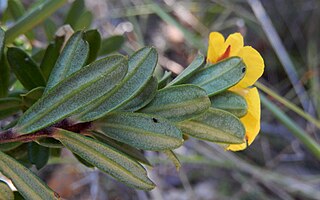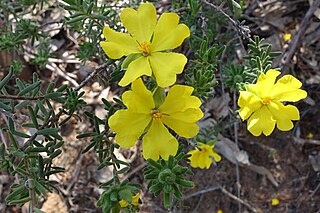
Hibbertia empetrifolia, commonly known as trailing guinea-flower, is a species of flowering plant in the family Dilleniaceae and is endemic to south-eastern Australia. It is a low-lying to spreading shrub with wiry stems, oblong to lance-shaped leaves with the narrower end towards the base, and pale to bright yellow flowers arranged on the ends of branchlets, with five to nine stamens arranged on one side of the two carpels.

Hibbertia hermanniifolia is a species of flowering plant in the family Dilleniaceae and is endemic to eastern Australia. It is an erect shrub with spatula-shaped to wedge-shaped leaves and yellow flowers arranged singly in leaf axils, with ten to fifteen stamens arranged around two hairy carpels.

Hibbertia bracteata is a species of flowering plant, in the family Dilleniaceae, and is endemic to eastern New South Wales. It is a shrub with lance-shaped to oblong leaves and yellow flowers with about sixteen stamens arranged on one side of the two carpels.

Hibbertia acuminata is a species of flowering plant in the family Dilleniaceae and is endemic to eastern Australia. It is an erect shrub with lance-shaped to egg-shaped, stem-clasping leaves and yellow flowers arranged singly in leaf axils with about forty stamens surrounding the carpels.
Hibbertia basaltica, commonly known as basalt guinea flower, is a species of flowering plant in the family Dilleniaceae and is endemic to Tasmania. It is a prostrate or low-lying subshrub with linear to oblong leaves and yellow flowers with five or six stamens arranged in a two groups on either side of the two carpels.
Hibbertia cactifolia is a species of flowering plant in the family Dilleniaceae and is endemic to the Arnhem Land escarpment. It is a multi-stemmed shrublet with hairy foliage, oblong to elliptic leaves and yellow flowers arranged singly in leaf axils, with twenty-six to twenty-eight stamens arranged in groups around the two carpels.
Hibbertia circularis is a species of flowering plant in the family Dilleniaceae and is endemic to the northern part of the Northern Territory. It is a perennial herb with prostrate, trailing branches, elliptic to more or less round leaves, and yellow flowers arranged in leaf axils, with thirty stamens arranged in groups around the two carpels.
Hibbertia circumdans is a species of flowering plant in the family Dilleniaceae and is endemic to New South Wales. It is an erect shrub with hairy branches, linear to wedge-shaped or spatula-shaped leaves, and yellow flowers arranged on short side shoots, with fifteen to thirty stamens arranged in groups around the three carpels.

Hibbertia covenyana is a species of flowering plant in the family Dilleniaceae and is endemic to New South Wales. It is an erect or semi-prostrate shrub with hairy foliage, oblong leaves and yellow flowers with seven to ten stamens arranged on one side of the two carpels.
Hibbertia demissa is a species of flowering plant in the family Dilleniaceae and is endemic to a restricted area of New South Wales. It is a low-lying shrublet with small elliptic leaves and single yellow flowers arranged on the ends of branchlets, with nine to twelve stamens arranged around three carpels.
Hibbertia eciliata is a species of flowering plant in the family Dilleniaceae and is endemic to a restricted area of Queensland. It is a sparsely-branched shrub with densely hairy foliage, elliptic and yellow flowers arranged singly on the ends of branchlets, with between fifty and fifty-four stamens arranged in groups around the two carpels.

Hibbertia fasciculiflora is a species of flowering plant in the family Dilleniaceae and is endemic to the south-west of Western Australia. It is an erect to spreading shrub with linear to narrow oblong leaves arranged in dense bunches near the ends of branchlets, and yellow flowers borne among the leaf bundles with eight to ten stamens all on one side of the two carpels.
Hibbertia florida is a species of flowering plant in the family Dilleniaceae and is endemic to New South Wales. It is a small shrub with oblong to lance-shaped leaves and yellow flowers arranged on the ends of branchlets, with twelve to twenty-eight stamens arranged around three carpels.
Hibbertia fumana is a species of flowering plant in the family Dilleniaceae and is endemic to New South Wales. It is a low-lying to prostrate shrublet with narrow oblong leaves and yellow flowers with five to seven stamens arranged in a single cluster on one side of two hairy carpels. When first formally described in 2012 it was thought to be extinct, but small populations have since been found in the Sydney region.
Hibbertia hexandra, commonly known as tree guinea flower, is a species of flowering plant in the family Dilleniaceae and is endemic to eastern Australia. It is a tall shrub or small tree with mostly lance-shaped leaves with the narrower end towards the base and yellow flowers arranged singly in leaf axils, with six stamens arranged around two hairy carpels.

Hibbertia horricomis is a species of flowering plant in the family Dilleniaceae and is endemic to the a restricted area of New South Wales. It is a small, erect to spreading shrub with hairy foliage, linear to elliptic leaves, and yellow flowers with about twenty stamens arranged around the two hairy carpels.
Hibbertia intermedia is a species of flowering plant in the family Dilleniaceae and is endemic to New South Wales. It is a small shrublet with linear to narrow oblong leaves and yellow flowers usually with seven to nine stamens arranged in a single cluster.

Hibbertia kaputarensis is a species of flowering plant in the family Dilleniaceae and is endemic to the Mount Kaputar area of New South Wales. It is a shrub with low-lying branches, oblong to lance-shaped leaves and yellow flowers with forty to about one hundred stamens arranged around three carpels.
Hibbertia ligulata is a species of flowering plant in the family Dilleniaceae and is endemic to the Northern Territory. It is a shrublet with hairy, wiry branches, linear leaves, and single yellow flowers arranged in leaf axils with twelve stamens arranged in bundles around the two carpels.
Hibbertia malacophylla is a species of flowering plant in the family Dilleniaceae and is endemic to Queensland. It is a spreading shrub with densely hairy foliage, elliptic leaves, and single yellow flowers arranged in leaf axils with 50 to 55 stamens arranged around the two carpels.








